Kona Manta Ray Night Snorkel: Ultimate Guide & Tips
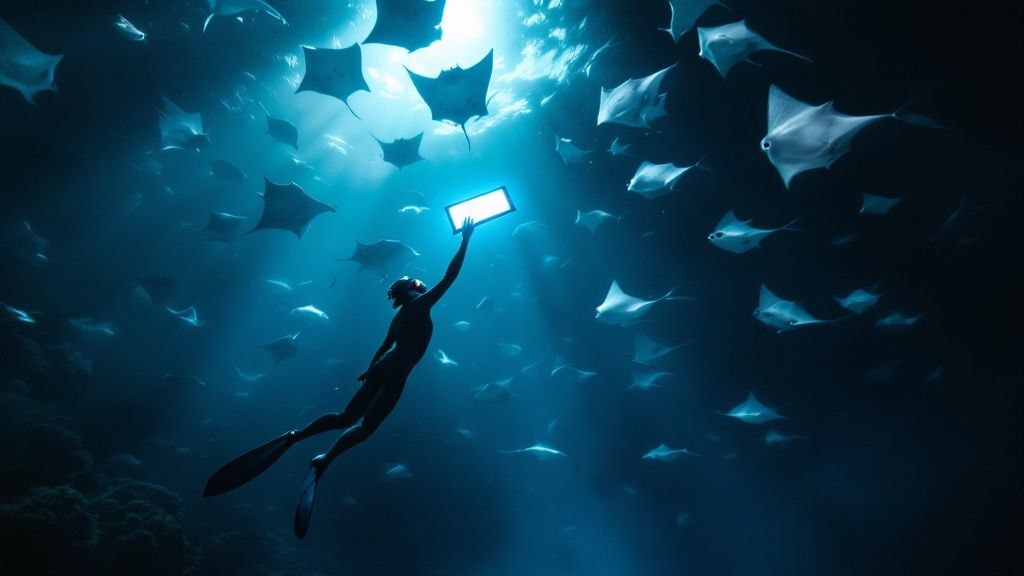
Imagine this: you're floating weightlessly on the calm, dark surface of the Pacific. Beneath you, a beam of light cuts through the darkness, and majestic manta rays, with wingspans wider than a car, glide and dance right before your eyes. This is the manta ray night snorkel in Kona, and it's an otherworldly experience that always tops the list of must-do adventures on the Big Island.
This guide will walk you through everything you need to know, from how this incredible encounter actually works to picking the right tour for this once-in-a-lifetime swim.
Experience Kona's World-Famous Manta Ray Snorkel
The manta ray night snorkel is so much more than just another tour; it’s like watching an underwater ballet performed by gentle giants. You feel a real, profound connection with the ocean. As one of Hawaii's signature wildlife encounters, this activity has earned a global reputation for its reliability and sheer awe factor. Drawing from our experience as Kona Snorkel Trips, the top rated & most reviewed snorkel company in Hawaii, we want to make sure you're totally prepared for this unforgettable adventure.
What makes this so special is the unique relationship that has developed between the tour operators and the local manta ray population. While many wildlife tours are a game of chance, the Kona snorkel has a ridiculously high success rate, often hitting over 90% year-round. This isn't luck. The mantas here aren't just passing through; they're residents who reliably show up for their nightly buffet.
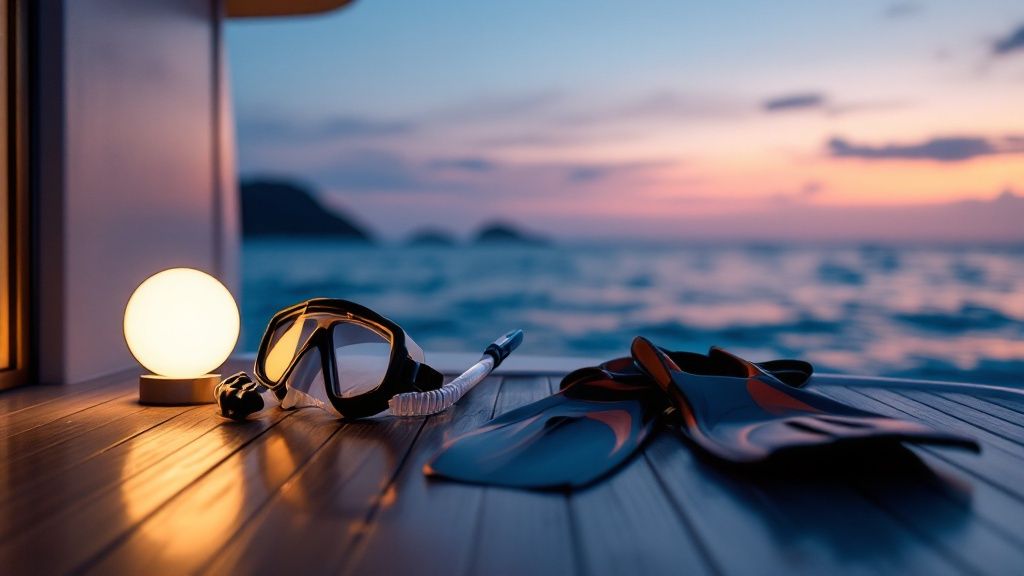
Why This Encounter Is a Must-Do
Your adventure starts with a short boat ride as the sun dips below the horizon, painting a stunning scene over the water. Once you arrive at the spot, powerful lights are submerged in the ocean. These lights attract swarms of plankton, which is the manta rays’ favorite meal. You then slip into the water and hold onto a custom-made float, becoming a silent observer from the surface.
The feeling is often described as surreal. You're just floating there in the dark, watching these massive, graceful creatures perform acrobatic barrel rolls just inches below you. It's peaceful, mesmerizing, and incredibly humbling.
For a lot of people, this encounter completely changes how they see marine life. The sheer size of the rays combined with their gentleness creates a powerful experience. And because of the safe, structured setup, it's an adventure that's perfect for almost everyone, including families and even those who aren't strong swimmers. As you plan your water adventures, it’s a good idea to explore all the amazing options Kona has to offer; learn more in our guide to the best snorkeling in Kona, HI.
Choosing Your Unforgettable Tour
This tour is incredibly popular, so booking with a reputable company is key to having a safe and ethical experience. A top-tier operator doesn't just hand you gear; they provide fantastic education about the rays and the importance of conservation. For a proven, highly-acclaimed adventure, we recommend the Kona Manta Ray Night Snorkel Tour. If that tour happens to be booked, Manta Ray Night Snorkel Hawaii is an exceptional alternative when looking for a Manta Ray night snorkel tour that also delivers an incredible experience.
Ready to see this natural wonder for yourself? Don't wait too long—spots for this bucket-list activity fill up fast!
How a Manta Ray Night Snorkel Actually Works
So, how in the world do tour operators get giant, wild manta rays to show up on cue nearly every single night? It’s not magic, but it feels pretty darn close. It's really just a brilliant bit of applied science, tapping into the manta's natural instincts.
The whole manta ray night snorkel in Kona is a finely tuned process, designed to give you a front-row seat to one of nature's greatest shows. It all starts with a boat ride as the sun dips below the horizon, painting the sky with those incredible Hawaiian sunset colors. That trip out to one of Kona’s manta sites is an experience in itself. Once the boat anchors, the real setup begins.
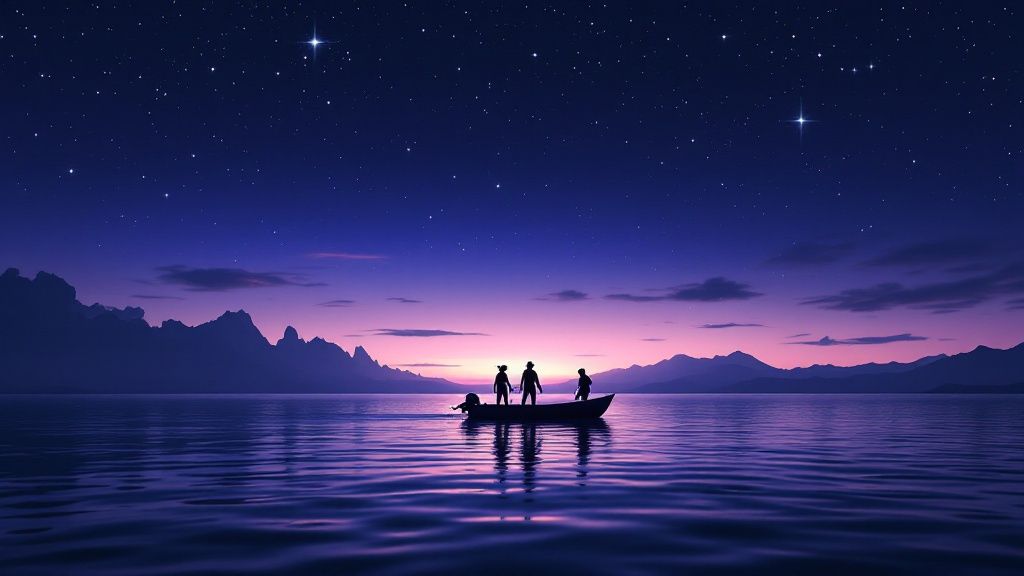
The Underwater Dinner Bell
The secret ingredient here is light—lots of it. Your guides will deploy a custom-built, powerful light board that floats on the surface. You can think of it as a glowing, floating dinner table set just for the mantas.
Those intense lights have one job: to attract plankton. These are the microscopic critters that reef manta rays love to eat. Within just a few minutes, the beams of light become a thick, shimmering cloud of these tiny organisms, creating a buffet that no passing manta can resist. This simple, ingenious method is why the tours have such a ridiculously high success rate.
It's pretty amazing when you think about it. The success rate for seeing manta rays on these tours is between 85% and 95% on most nights. That makes Kona one of the most reliable places on the entire planet to see these animals in the wild. This all comes down to the light board creating a dependable feeding station. For a deeper dive, check out the details on how this unique method works on konasnorkeltrips.com.
Your Front-Row Seat
Once the "dinner table" is set, it's your turn to slip into the water. Don't worry, you won't be swimming around trying to chase them. You'll just grab onto handles on the light board and float right on the surface, looking down into the action. The wetsuit keeps you warm and buoyant, so it’s all about relaxing and watching the show.
From this spot, you become a silent observer of an incredible performance. When the mantas arrive, they start feeding, gliding and swooping through the light beams with unbelievable grace. You'll see them do acrobatic barrel rolls and somersaults, sometimes coming just inches away as they gulp down mouthfuls of plankton. It’s totally surreal—both peaceful and mind-blowingly exciting at the same time.
We often describe it as an underwater ballet. The mantas are the dancers, the light is their stage, and you've got the best seat in the house. It's a completely passive experience that allows for an amazingly intimate and respectful encounter.
Manta Village vs. Manta Heaven
Here in Kona, the action happens at two world-famous sites, each with its own vibe:
-
Manta Village (Keauhou Bay): This is the original spot, right offshore from the Sheraton Kona Resort. It has a shallow, sandy bottom that reflects the light beautifully, making for great viewing. The success rate is consistently sky-high, and the boat ride from Keauhou Bay is super short.
-
Manta Heaven (Garden Eel Cove): This spot is a bit north of Kona, closer to the airport. It can sometimes attract even larger groups of mantas, though sightings can be a tiny bit less consistent than at Manta Village. The bottom here is more volcanic rock, giving it a different look.
Honestly, both locations offer a spectacular chance to witness this phenomenon. Your tour operator will usually pick the spot they think will have the best activity on any given night. No matter which one you end up at, the underwater ballet will be waiting.
Meet Kona's Resident Gentle Giants
The manta rays you'll meet on a manta ray night snorkel in Kona aren't just passing through. They're part of a local, well-studied population of gentle giants, and each one is a unique individual known and loved by the guides and researchers here. Knowing a little about them turns this incredible adventure from just a tourist activity into a real connection with one of the ocean's smartest creatures.
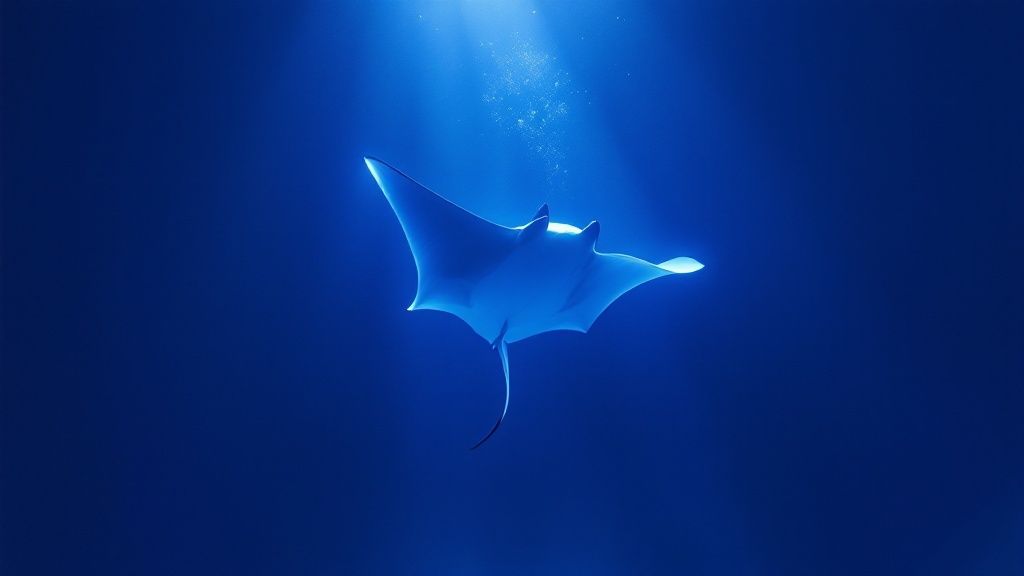
The main species you'll encounter is the reef manta ray (Mobula alfredi), which is the second-largest ray species on the planet. Their size is just breathtaking, with wingspans often stretching over 12 feet from tip to tip.
Despite how huge they are, they are completely harmless. They're filter feeders with no teeth, barbs, or stingers. Their gentle and curious nature is actually one of the most amazing parts of the whole experience. A lot of people are surprised by this, and you can dive deeper into why manta rays are safe to swim with in our other article.
Identifying The Locals
What really makes the Kona population special is that so many of them have names. How's that possible? Well, every single manta ray has a unique pattern of black spots on its white belly, almost like a human fingerprint.
For decades, local researchers and conservation groups have been meticulously photographing and cataloging these spot patterns. This has created a massive database of individual mantas, allowing them to recognize specific rays like "Lefty," "Big Bertha," or "Kailey Ray" whenever they show up.
This ongoing effort gives us priceless information on their life cycles, social habits, and the overall health of the population. It’s a perfect example of how tourism and science can team up to protect a vulnerable species. When your guide points out a manta by name, you’re not just looking at a fish; you're meeting a recognized member of the Kona community.
The connection feels personal. Knowing that the manta ray gliding below you has a name and a history deepens the sense of wonder and underscores the importance of protecting these incredible animals for future generations.
The Famous Barrel Roll And Other Behaviors
During your snorkel, you'll be front and center for their main activity—feeding. Manta rays are filter feeders, which means they eat huge amounts of tiny plankton by swimming with their giant mouths wide open. The lights from your tour's float act like a magnet for the plankton, and the mantas swoop in for the buffet.
You'll probably get to see a few fascinating feeding moves:
- The Barrel Roll: This is their signature move. A manta will perform a graceful, acrobatic somersault right through the thickest cloud of plankton to get the most food in a single pass. It's truly a sight to behold.
- Surface Feeding: You might see them skimming the very top of the water, with the tips of their cephalic fins (the horn-like fins on their head) breaking the surface as they scoop up plankton.
- Chain Feeding: Sometimes, several mantas will line up nose-to-tail, creating a "feeding train." This lets them swim through the plankton cloud together in a super-efficient way.
The local population is watched over carefully. It’s estimated that over 450 individual manta rays call the Kona coast home, with dedicated groups cataloging more than 120 of them each year. This incredible effort helps track their health and movements, which is vital for the sustainable future of this amazing eco-tourism experience.
Preparing for Your Manta Ray Adventure
A little bit of planning is all it takes to turn a great manta trip into a truly perfect one. Nailing a few small details beforehand means you can relax and just soak in the incredible underwater show once you're out on the water.
The easiest way to do it is to show up at the marina ready to jump in. Wear your swimsuit under your clothes—it makes the pre-snorkel change on the boat a breeze. And trust me, you'll be happy you brought a warm towel and some dry clothes for the ride back to shore after you get out of the water.
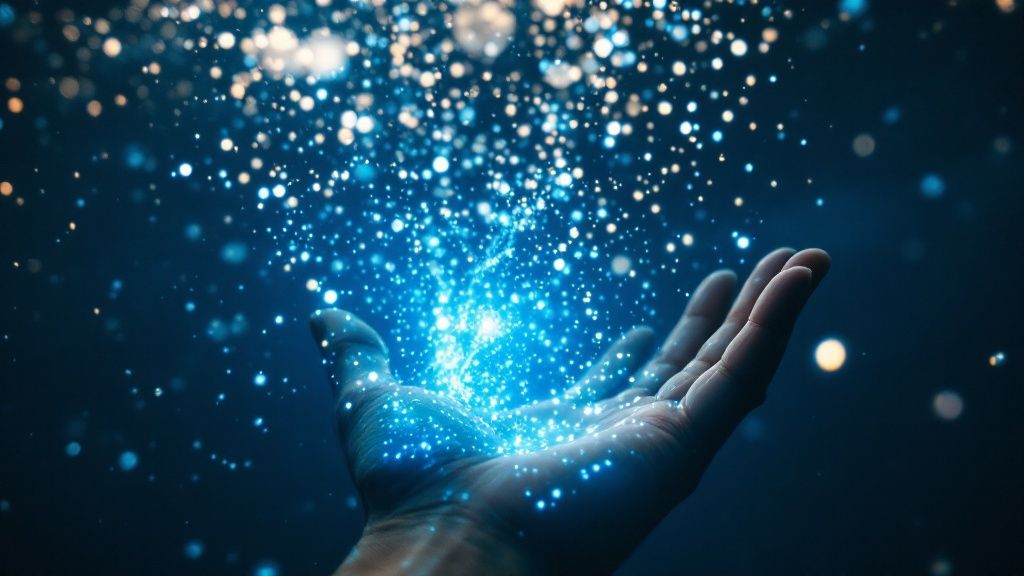
What to Pack and What to Leave
Don't worry about the big stuff. Your tour operator provides all the essential gear you need: wetsuit, snorkel, mask, and fins. That means you can, and should, pack light.
Here’s a quick and easy checklist to get you ready:
-
Essentials to Bring:
- Towel: A no-brainer for drying off after the snorkel.
- Dry Clothes: A sweatshirt or light jacket is a great idea. It can get chilly on the boat ride back, even in Hawaii.
- Reusable Water Bottle: Always smart to stay hydrated.
- Underwater Camera: Got a GoPro? Bring it! Just make sure it's got a solid wrist strap so it doesn't end up on the ocean floor.
-
What to Leave Behind:
- Valuables: Your nice jewelry, wallet, and other electronics are safer back in your hotel safe.
- Non-Reef-Safe Sunscreen: This is a night tour, so sunscreen isn't really a thing. Still, it's a good habit to only use reef-safe products any time you're in Hawaiian waters.
- Large Bags: Space is tight on the boat. A small bag with just your essentials is all you need.
Addressing Common Concerns
If you're a first-timer, you probably have a few questions. That's completely normal! The good news is, this adventure is designed for just about everyone.
You definitely don't need to be a world-class swimmer. The experience is really passive—you'll just be holding onto a big, stable light board and floating. The wetsuit gives you plenty of buoyancy, so as long as you're comfortable in the water, you're good to go. The guides are right there in the water with you the whole time, making sure everyone feels safe.
One of the biggest worries we hear about is seasickness. To head it off, think about taking a non-drowsy motion sickness medication about an hour before your tour. It’s a super simple step that can make a world of difference for your comfort on the boat.
People also ask about the best time of year to go. The fantastic news is there isn't one! The mantas are residents here and feed all year round. That means sightings are highly reliable no matter when you visit Kona. It’s a huge part of what makes the manta ray night snorkel in Kona such a dependable bucket-list trip.
And finally, if you're hoping to get some epic photos or videos, a little camera prep helps. It's dark out there, so get familiar with your camera's low-light or night settings before you get on the boat. Try to avoid using a powerful external flash, as the bright burst of light can bother the mantas. A red light filter is also a great tool for bringing out more natural colors in your shots.
With these few things in mind, you'll be all set for an unforgettable evening with Kona’s gentle giants.
Why Safe and Sustainable Snorkeling Matters
Being in the water with Kona's manta rays is more than just a cool activity—it’s a privilege. This whole incredible encounter is built on a foundation of mutual respect between us, the mantas, and their ocean home. Being a responsible, educated visitor is the single best way to make sure this magical experience is around for generations to come.
Reputable operators like us at Kona Snorkel Trips live and breathe this stuff. We follow strict safety and sustainability rules, starting with our expert, in-water guides. They’re constantly keeping an eye on both our guests and the mantas, making sure everyone is safe and comfortable. We also provide essentials like warm wetsuits, which do more than just keep you from getting chilled—they help you float effortlessly, making it much easier to just relax on the surface.
The Golden Rule of Manta Encounters
If you remember one thing, make it this: passive observation. You're there to watch the show, not be a part of it. The main idea is simple but absolutely critical: do not touch the manta rays. Ever.
Manta rays have this incredibly delicate, paper-thin layer of protective mucus covering their skin. You can think of it as their immune system; it's what shields them from nasty bacteria and parasites in the water. When a person touches a manta, that vital slime gets rubbed off, leaving the animal wide open to some potentially serious infections.
Following the "no touching" rule is the most direct and powerful way you can help protect Kona's resident manta ray population. Your respect literally keeps them safe.
Besides the risk of physical harm, touching or chasing a manta completely disrupts their natural behavior. Remember, the whole reason they show up to the lights is to eat. Any interference from us can stress them out and cause them to leave the area. By simply floating and watching, you let them feed in peace, just as they naturally would.
Other Eco-Friendly Practices to Follow
Being a good ocean guest goes beyond just the "no touching" rule. Following a few other simple guidelines makes a huge difference in protecting the entire marine ecosystem.
- Reef-Safe Sunscreen: Okay, this is a night tour, but it's a fantastic habit to get into for all your ocean time in Hawaii. The chemicals in regular sunscreens are super toxic to our coral reefs and marine life. Always, always choose a mineral-based sunscreen with non-nano zinc oxide.
- Avoid Kicking and Splashing: Once you're in the water, just try to be calm and still. Thrashing around can disturb the mantas and stirs up sediment from the bottom, which messes with the whole scene.
- Listen to Your Guides: Your guides are the experts here. They know manta ray behavior and all the safety protocols inside and out. Following their instructions is the best way to guarantee a safe, respectful, and totally amazing experience for you and everyone else in the water.
When you stick to these simple but vital rules, you become a partner in conservation. Your thoughtful behavior ensures that the world-famous Kona manta ray night snorkel remains an ethical and sustainable wildlife encounter, preserving the magic for all future visitors and—most importantly—for the mantas themselves.
Choosing the Right Manta Ray Snorkel Tour
With the whole world buzzing about the manta ray night snorkel in Kona, it’s no surprise a bunch of tour operators have popped up. Picking the right one is the difference between a good trip and a truly unforgettable, safe, and ethical encounter. It really just comes down to knowing what to look for.
The best companies always shine in a few key areas. First and foremost is an impeccable safety record, which means having experienced, certified guides in the water with you. Another huge factor is group size. Smaller groups almost always mean a more personal, less crowded experience where you actually get a great view without feeling like you're in a crowd.
And a genuine commitment to manta ray conservation? That’s not just a nice bonus—it's absolutely essential. This means the operator is serious about following all the rules for passive observation, making sure the well-being of the rays is always the top priority.
Key Qualities of a Premier Tour Operator
When you're looking at your options, keep an eye out for these things that really set a top-tier tour apart:
- Experienced Crew: You want guides who are not only safety-certified but are also marine naturalists. The best ones can tell you all about manta ray behavior and biology, making the experience that much richer.
- High-Quality Gear: A good operator will have clean, well-maintained gear, including warm wetsuits. Trust me, you'll be glad you have one for a night snorkel!
- Small Group Advantage: A smaller guide-to-guest ratio means you get more personal attention and have plenty of space to enjoy the show without bumping into other snorkelers.
- Conservation Focus: The best tours are passionate about protecting the mantas. They'll give you a thorough briefing on the "no touching" rule and other important eco-friendly practices.
An operator's dedication to these principles directly shapes your experience and, more importantly, the health of the manta ray population. Choosing a company that respects the animals ensures this amazing encounter will be around for years to come.
Booking Your Adventure in Advance
I can't overstate how popular this experience is. Kona's manta ray snorkeling tours see about 80,000 people every year, so booking your tour well in advance is absolutely critical.
Most operators recommend making your reservation at least two weeks ahead, especially if you're coming during peak season. You can learn more about the logistics from outfits like konahonudivers.com.
Our Top Recommendations
For a proven, top-rated experience that checks all the boxes, we highly recommend booking with a trusted provider. Kona Snorkel Trips is known for its exceptional service and commitment to responsible tourism. You can secure your spot on their unforgettable manta ray snorkel tour.
If they happen to be fully booked, Manta Ray Night Snorkel Hawaii is another fantastic and highly-regarded alternative known for providing incredible encounters. For more tips on making the right choice, check out our detailed guide on the best manta ray night snorkel in Kona.
Ready to secure your spot for this bucket-list adventure?
Got Questions? We’ve Got Answers.
It's totally normal to have a few questions popping into your head before you commit to an adventure like the manta ray night snorkel in Kona. After years of guiding these tours, we've heard them all. To set your mind at ease, here are the straight-up answers to the most common things people ask.
Is This Really Safe If I'm Not a Great Swimmer?
One hundred percent. We've designed this experience to be incredibly safe and welcoming for everyone, even if you can barely doggy paddle. You're not just thrown into the open ocean.
First, you'll be zipped into a warm, super-buoyant wetsuit. Then, you'll hold onto a large, sturdy light board the entire time. You never actually have to swim on your own. Our professional guides are right there in the water with you, making sure everyone feels secure and comfortable. It's a fantastic and perfectly safe outing for the whole family.
What if the Manta Rays Don't Show Up?
This is a big one, and it's a fair question. These are wild animals, after all, and we can't exactly send them an invitation. That said, the Kona snorkel has an incredible success rate—we see mantas well over 90% of the time. It’s genuinely one of the most reliable wildlife encounters on the planet.
To give you total peace of mind, nearly every reputable operator offers a 'manta guarantee.' In the slim chance that your tour is one of those rare nights where the mantas are a no-show, they'll bring you back out on another tour for free, depending on availability.
This policy just shows how confident the local operators are. Our best advice? Book your snorkel early in your vacation. That way, if you do need to reschedule, you've got plenty of time in your itinerary to do so.
Can I Bring My GoPro?
Absolutely! Bringing an underwater camera like a GoPro is a great idea—capturing the magic is half the fun. Just make sure it’s got a solid wrist strap so it doesn't take a one-way trip to the ocean floor.
A little pro-tip: play around with your camera's low-light or night settings before you're on the boat. Also, please don't use a powerful external flash. The sudden bursts of bright light can really spook the mantas and mess up their feeding groove. Many boats also have a pro videographer on board capturing unbelievable footage you can buy later, which is a great option if you just want to stay in the moment.
Why Is Touching the Manta Rays a Huge No-No?
This is the single most important rule of the entire experience, and it's all about protecting Kona's amazing manta population. Their skin is covered by a super-thin layer of mucus, which is basically their immune system. It’s what protects them from nasty infections and parasites.
When we touch them, even gently, we rub off that protective slime and leave them vulnerable to getting sick. It also disrupts their natural feeding behavior and causes them stress, which might make them leave the area altogether. By just floating and watching, you become a guardian of these incredible animals and help ensure they'll be here for generations to come.
